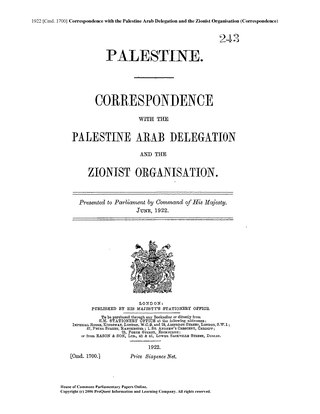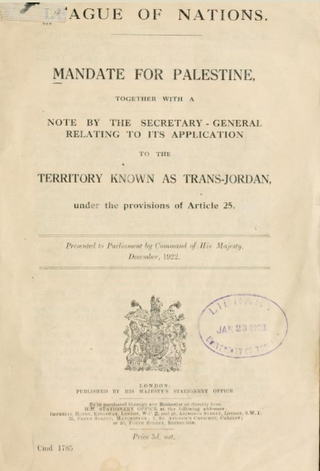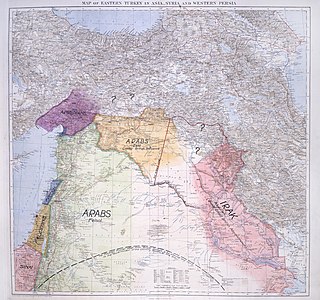
The Balfour Declaration was a public statement issued by the British Government in 1917 during the First World War announcing its support for the establishment of a "national home for the Jewish people" in Palestine, then an Ottoman region with a small minority Jewish population. The declaration was contained in a letter dated 2 November 1917 from the United Kingdom's Foreign Secretary Arthur Balfour to Lord Rothschild, a leader of the British Jewish community, for transmission to the Zionist Federation of Great Britain and Ireland. The text of the declaration was published in the press on 9 November 1917.

The San Remo conference was an international meeting of the post-World War I Allied Supreme Council as an outgrowth of the Paris Peace Conference, held at Castle Devachan in Sanremo, Italy, from 19 to 26 April 1920. The San Remo Resolution passed on 25 April 1920 determined the allocation of Class "A" League of Nations mandates for the administration of three then-undefined Ottoman territories in the Middle East: "Palestine", "Syria" and "Mesopotamia". The boundaries of the three territories were "to be determined [at a later date] by the Principal Allied Powers", leaving the status of outlying areas such as Zor and Transjordan unclear.

The Sykes–Picot Agreement was a 1916 secret treaty between the United Kingdom and France, with assent from the Russian Empire and the Kingdom of Italy, to define their mutually agreed spheres of influence and control in an eventual partition of the Ottoman Empire.
The McMahon–Hussein Correspondence is a series of letters that were exchanged during World War I in which the Government of the United Kingdom agreed to recognize Arab independence in a large region after the war in exchange for the Sharif of Mecca launching the Arab Revolt against the Ottoman Empire. The correspondence had a significant influence on Middle Eastern history during and after the war; a dispute over Palestine continued thereafter.

The Churchill White Paper of 3 June 1922 was drafted at the request of Winston Churchill, then Secretary of State for the Colonies, partly in response to the 1921 Jaffa Riots. The official name of the document was Palestine: Correspondence with the Palestine Arab Delegation and the Zionist Organisation. The white paper was made up of nine documents and "Churchill's memorandum" was an enclosure to document number 5. While maintaining Britain's commitment to the Balfour Declaration and its promise of a Jewish national home in Mandatory Palestine, the paper emphasized that the establishment of a national home would not impose a Jewish nationality on the Arab inhabitants of Palestine. To reduce tensions between the Arabs and Jews in Palestine the paper called for a limitation of Jewish immigration to the economic capacity of the country to absorb new arrivals. This limitation was considered a great setback to many in the Zionist movement, though it acknowledged that the Jews should be able to increase their numbers through immigration rather than sufferance.

The Faisal–Weizmann agreement was signed by Emir Faisal, the third son of Hussein ibn Ali al-Hashimi, King of the short-lived Kingdom of Hejaz, and Chaim Weizmann, President of the Zionist Organization on 3 January 1919. Signed two weeks before the start of the Paris Peace Conference, it was presented by the Zionist delegation alongside a March 1919 letter written by T. E. Lawrence in Faisal's name to American Zionist leader Felix Frankfurter as two documents to argue that the Zionist plans for Palestine had prior approval of Arabs.

Tel Hai is a name of the former Jewish settlement in northern Galilee, the site of an early battle between Jews and Arabs heralding the growing civil conflict, and of a monument, tourist attraction, and a college. It is currently part of kibbutz Kfar Giladi.

The King–Crane Commission, officially called the 1919 Inter-Allied Commission on Mandates in Turkey, was a commission of inquiry concerning the disposition of areas within the former Ottoman Empire.

The Anglo-French Declaration was published by Great Britain and France, shortly after the Armistice of Mudros saw the capitulation of the Ottoman Empire. Some sources mention as publication date 7 November 1918, others 9 November 1918.

Elie Kedourie was a British historian of the Middle East. He wrote from a liberal perspective, dissenting from many points of view taken as orthodox in the field. From 1953 to 1990, he taught at the London School of Economics, where he became Professor of Politics. Kedourie was famous for his rejection of what he called the "Chatham House version" of history, which viewed the story of the modern Middle East as one of continuous victimisation at the hands of the West, and instead castigated left-wing Western intellectuals for what he regarded as a naively romantic view of Islam.

The partition of the Ottoman Empire was a geopolitical event that occurred after World War I and the occupation of Constantinople by British, French, and Italian troops in November 1918. The partitioning was planned in several agreements made by the Allied Powers early in the course of World War I, notably the Sykes–Picot Agreement, after the Ottoman Empire had joined Germany to form the Ottoman–German Alliance. The huge conglomeration of territories and peoples that formerly comprised the Ottoman Empire was divided into several new states. The Ottoman Empire had been the leading Islamic state in geopolitical, cultural and ideological terms. The partitioning of the Ottoman Empire after the war led to the domination of the Middle East by Western powers such as Britain and France, and saw the creation of the modern Arab world and the Republic of Turkey. Resistance to the influence of these powers came from the Turkish National Movement but did not become widespread in the other post-Ottoman states until the period of rapid decolonization after World War II.
The Declaration to the Seven was a document written by Sir Mark Sykes, approved by Charles Hardinge, the Permanent Under-Secretary at the Foreign Office and released on June 16, 1918 in response to a memorandum issued anonymously by seven Syrian notables in Cairo that included members of the soon to be formed Syrian Unity Party, established in the wake of the Balfour Declaration and the November 23, 1917 publication by the Bolsheviks of the secret May 1916 Sykes-Picot Agreement between Britain and France. The memorandum requested a "guarantee of the ultimate independence of Arabia". The Declaration stated the British policy that the future government of the regions of the Ottoman Empire occupied by Allies of World War I "should be based upon the principle of the consent of the governed".

Sir Vincent Arthur Henry McMahon was a British Indian Army officer and diplomat who served as the High Commissioner in Egypt from 1915 to 1917. He was also an administrator in British India and served twice as Chief Commissioner of Baluchistan. McMahon is best known for the McMahon-Hussein Correspondence with Hussein bin Ali, Sharif of Mecca, the McMahon Line between Tibet and India, and the Declaration to the Seven in response to a memorandum written by seven notable Syrians. After the Sykes-Picot Agreement was published by the Bolshevik Russian government in November 1917, McMahon resigned. He also features prominently in Seven Pillars of Wisdom, T.E. Lawrence's account of the Arab Revolt against the Ottoman Empire during World War I.

The 1921 Cairo Conference, described in the official minutes as Middle East Conference held in Cairo and Jerusalem, March 12 to 30, 1921, was a series of meetings by British officials for examining and discussing Middle Eastern problems, and to frame a common policy. The secret conference of British experts created the blueprint for British control in both Iraq and Transjordan. By offering nominal leadership of those two regions to the sons of the Sharif of the Mecca, Churchill felt that the spirit if not the actual letter of Britain's wartime promises to the Arabs were fulfilled.
The De Bunsen Committee was the first committee established by the British government to determine its policy toward the Ottoman Empire during and following World War I. The committee was established on 8 April 1915 by British Prime Minister H. H. Asquith, and was headed by Maurice de Bunsen. The committee submitted its report on 30 June 1915.

The Arab Kingdom of Syria was a self-proclaimed, unrecognized constitutional monarchy existing briefly in the territory of historical Syria. It was announced on 5 October 1918 as a fully independent Arab constitutional government with the permission of the British military. It gained de facto independence as an Emirate after the withdrawal of the British forces from OETA East on 26 November 1919, and was proclaimed as a Kingdom on 8 March 1920.

The Mandate for Palestine was a League of Nations mandate for British administration of the territories of Palestine and Transjordan, both of which had been conceded by the Ottoman Empire following the end of World War I in 1918. The mandate was assigned to Britain by the San Remo conference in April 1920, after France's concession in the 1918 Clemenceau–Lloyd George Agreement of the previously-agreed "international administration" of Palestine under the Sykes–Picot Agreement. Transjordan was added to the mandate after the Arab Kingdom in Damascus was toppled by the French in the Franco-Syrian War. Civil administration began in Palestine and Transjordan in July 1920 and April 1921, respectively, and the mandate was in force from 29 September 1923 to 15 May 1948 and to 25 May 1946 respectively.
The Bassett Letter was a letter dated 8 February 1918 from the British Government to Hussein bin Ali, Sharif of Mecca, following Hussein's request for an explanation of the Sykes-Picot Agreement. It was delivered by Lieutenant colonel J. R. Bassett, Acting British Agent at Jeddah, who was forwarding a message he had received by telegram from the Foreign Office in London.
The Interregnum period in Transjordan was a short period during which Transjordan had no established ruler or occupying power that lasted from the end of the Franco-Syrian War on 25 July 1920 until the Establishment of the Emirate of Transjordan in April 1921.

The Sharifian or Sherifian Solution, was an informal name for post-Ottoman British Middle East policy and French Middle East policy of nation-building. As first put forward by T. E. Lawrence in 1918, it was a plan to install the three younger sons of Hussein bin Ali al-Hashimi as heads of state in newly created countries across the Middle East, whereby his second son Abdullah would rule Baghdad and Lower Mesopotamia, his third son Faisal would rule Syria, and his fourth son Zeid would rule Upper Mesopotamia. Hussein himself would not wield any political power in these places, and his first son, Ali would be his successor in Hejaz.















